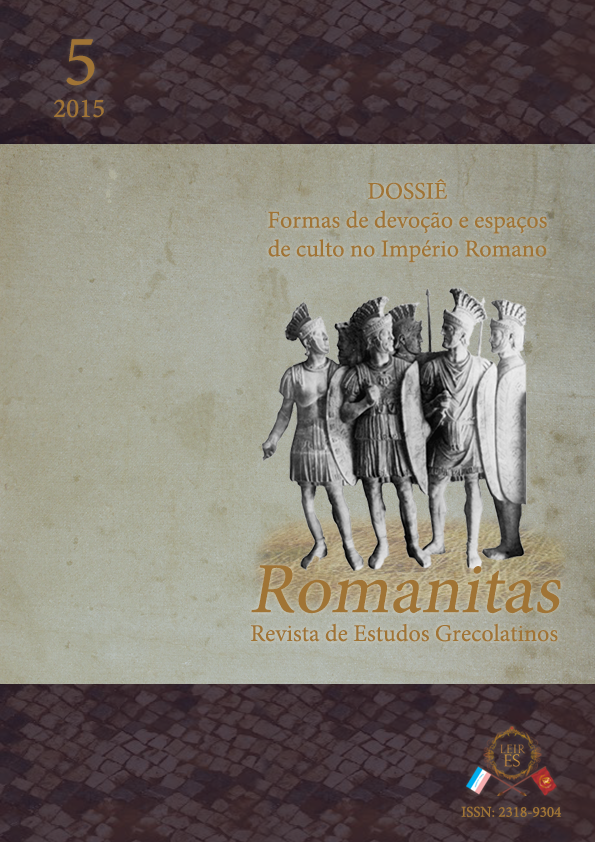Devoção, espaço de culto e poder: o ressoar de 'Theotokos' na basílica de Santa Maria Maggiore (século V)
DOI:
https://doi.org/10.17648/rom.v0i5.11215Palavras-chave:
Império Romano, Basílica de Santa Maria Maggiore, Mosaicos, Marianismo, Poder episcopalResumo
O presente artigo tem como objetivo analisar a construção da basílica de Santa Maria Maggiore, com destaque para os mosaicos marianos localizados no arco triunfal, de modo a apreender os motivos pelos quais estes foram ali engendrados. Ademais, buscamos compreender como a devoção a Maria se estabeleceu no local, contribuindo para a legitimação da autoridade do bispo de Roma, que passou a representar a emanação do poder e dos desígnios divinos.Downloads
Referências
Documentação textual
BÍBLIA. Português. Trad. da École Biblique de Jerusalém. Bíblia de Jerusalém revista e ampliada. São Paulo: Paulus, 2006.
BÍBLIA. Português-Grego. Trad. Ferreira de Almeida e NTLH. Novo Testamento Interlinear Grego-Português. São Paulo: Sociedade Bíblica do Brasil, 1994.
EDICT OF VALENTINIAN III. In: RIDDLE, J. E. The History of the Papacy: to the Period of the Reformation. London: Richard Bentley, 1856. v. 1.
INFANCY GOSPEL OF PSEUDO-MATTHEWS. In: ELLIOT, J. K. The Apocryphal New Testament: a collection of Apocryphal Christian. New York: Oxford University Press, 2005.
THE PROTEVANGELIUM OF JAMES. In: ELLIOT, J. K. The Apocryphal Nova Testament: a collection of Apocryphal Christian. New York: Oxford University Press, 2005.
VIRGILE. Bucoliques. Texte établi et traduit par Henri Goelzer. Paris: Les Belles Lettres, 1956.
Documentação visual e epigráfica
EPIGRAFIA 976. In: DIEHL, E. Inscriptiones Latinae Christianae Veteres (ILCV). Berlin: Weidmann, 1931.
MOSAICO DA ANUNCIAÇÃO. Arco Central. Basílica de Santa Maria Maggiore. Arquivo fotográfico Lozzi Roma, Roma, 2012.
MOSAICO DA APRESENTAÇÃO DE JESUS. Arco Central. Basílica de Santa Maria Maggiore. Arquivo fotográfico Lozzi Roma, Roma, 2012.
MOSAICO DA FUGA PARA O EGITO. Arco Central. Basílica de Santa Maria Maggiore. Arquivo fotográfico Lozzi Roma, Roma, 2012.
MOSAICO DA VISITAÇÃO DOS REIS MAGOS. Arco Central. Basílica de Santa Maria Maggiore. Arquivo fotográfico Lozzi Roma, Roma, 2012.
MOSAICO DE PEDRO E PAULO. Arco Central. Basílica de Santa Maria Maggiore. Arquivo fotográfico Lozzi Roma, Roma, 2012.
Obras de apoio
ADKINS, L.; ADKINS, R. Handbook to life in Ancient Rome. New York: Facts on File, 2004.
BALCH, D. L.; OSIEK, C. Early Christian families in context. Michigan-Cambridge: Eerdmans Publishing, 2003.
BEATTIE, T. New Catholic Feminism: Theology and Theory. London and New York: Routledge, 2006.
BENKO, S. The Magnificat: a history of the controversy. Journal of Biblical Literature, The Society of Biblical Literature, v. 86, n. 3, p. 263-275, 1967.
BOVINI, G. Guide to Basilica of Santa Maria Maggiore. Roma: ATS Italia, 1996.
BRENK, B. Art and Propaganda fide: Christian art and architecture (300-600). In: MITCHELL, M. M.; YOUNG, F. M. (Eds.). Cambridge History of Christianity. New York: Cambridge University Press, 2008. p. 691-725. v. 2.
CLELAND, L; DAVIES, G; LLEWELLYN-JONES, L. Greek and Roman dress from A to Z. New York: Routledge, 2007.
FOUCAULT, M. Microfísica do poder. Rio de Janeiro: Graal, 1979.
FROTHINGHAM, A. L. Notes on Christian Mosaics (II). The Portico of the Lateran Basilica. The American Journal of Archaeology and of the History of the Fine Arts, v. 2, n. 4, p. 414-423, 1886.
GWYNN, D.; BANGERT, S. Religious diversity in Late Antiquity. Leiden: BRILL, 2010.
HENDY, M. Catalogue of the Byzantine Coins in the Dumbarton Oaks Collection and in the Whittemore Collection (Parte 1). Washington: Dumbarton, 1999. v. 4.
KRAUTHEIMER, R. The Carolingian Revival of Early Christian Architecture. In: KLEINBAUER, E. Modern perspectives in Western Art History: an Anthology of Twentieth-century writing on the visual arts. New York: Holt, Rinehart and Winston, 1989.
LANSFORD, Tyler. The Latin inscriptions of Rome: a Walking Guide. Baltimore: John Hopkins University Press, 2009.
LUDWIG, F. C. Topographical and panoramic survey of the campagna di Roma, with reference to Geology, History, and Antiquities. London: R. Ackermann, 1818.
MACLAREN, S. Seeing the Whole Picture: A “Madonna and Child” in the Collection of the Walters Art Museum and the “Praesepe” of Santa Maria Maggiore. The Journal of the Walters Art Museum. The Walters Art Museum. v. 63, p. 15-30, 2005.
MC EVOY, M. A. Child emperor rule in the late roman west (A.D. 367-455). Oxford: Oxford University, 2013.
MILES, M. R. Santa Maria Maggiore’s Fifth-Century Mosaics: triumphal Christianity and the Jews. The Harvard Theological Review, v. 86, n. 2. New York: Cambridge University Press, 1993.
PHILIP, N; WILKINSON, P. Eyewitness companions: Mythology. New York: DK, 2007.
SCHERS, J. The status of episcopal authority in Rome (312–461 AD). Amsterdam: Radboud University Nijmegen, 2013.
SHESTACK, A. Introduction. In: Catalog of iconography. Washington: National Gallery of Art, 1967.
SIEGER, J. D. Visual metaphor as theology: Leo the Great’s Sermons on the Incarnation and the arch. Mosaics at S. Maria Maggiore. Gesta. v. 26, n. 2, p. 83-91, 1987.
SPAIN, S. “The Promised Blessing”: the iconography of the Mosaics of S. Maria Maggiore. The Art Bulletin. v. 61, n. 4, p. 518-540, 1979.
WEBB, M. The churches and catacombs of Early Christian Rome: a comprehensive guide. Brighton: Sussex Academic Press, 2001.
WESTGATE, R. Pavimenta atque emblemata vermiculata: regional styles in Hellenistic Mosaic and the First Mosaics at Pompeii. American Journal of Archaeology. v. 104, n. 2, p. 255-275, 2000.
Downloads
Publicado
Como Citar
Edição
Seção
Licença
Copyright (c) 2015 Romanitas - Revista de Estudos Grecolatinos

Este trabalho está licenciado sob uma licença Creative Commons Attribution-NonCommercial-NoDerivatives 4.0 International License.
a. Os autores mantêm os direitos autorais e concedem à revista o direito de primeira publicação.
b. Os autores têm autorização para assumir contratos adicionais separadamente, para distribuição não-exclusiva da versão do trabalho publicada nesta revista (ex.: publicar em repositório institucional ou como capítulo de livro), com reconhecimento de autoria e publicação inicial nesta revista.
c. Autores têm permissão e são estimulados a publicar e distribuir seu trabalho online (ex.: em repositórios institucionais ou na sua página pessoal) após a primeira publicação pela revista, com os devidos créditos.
d. Os textos da revista estão licenciados com uma Licença CC BY 4.0 Deed Atribuição 4.0 Internacional (CC BY).




























